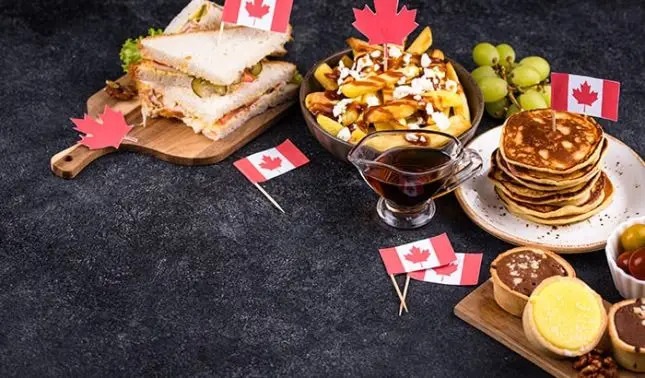In a more globalized food industry, proper nutrition facts label requirements have become a cornerstone of successful international trade and consumer trust. For food manufacturers navigating multiple markets, understanding and implementing correct nutritional information across different regulatory frameworks isn’t just about compliance — it’s about building brand credibility and ensuring market access.
Whether you’re a startup food business or an established manufacturer, mastering nutrition labeling requirements across the FDA, UK, COFEPRIS, and CFIA jurisdictions is crucial for sustainable growth in the food and beverage products sector. With tools like Food Label Maker, you can simplify this process by creating a food label in just a few clicks or viewing our pricing plans to find the right package for your business needs.
This article will outline the nutrition facts label standards in different countries and guide you through regulatory requirements so you can remain compliant and build trust with your customers.
See How FoodLabelMaker Can Help You
Standard Nutrition Facts Labels Across Regions
FDA (US)
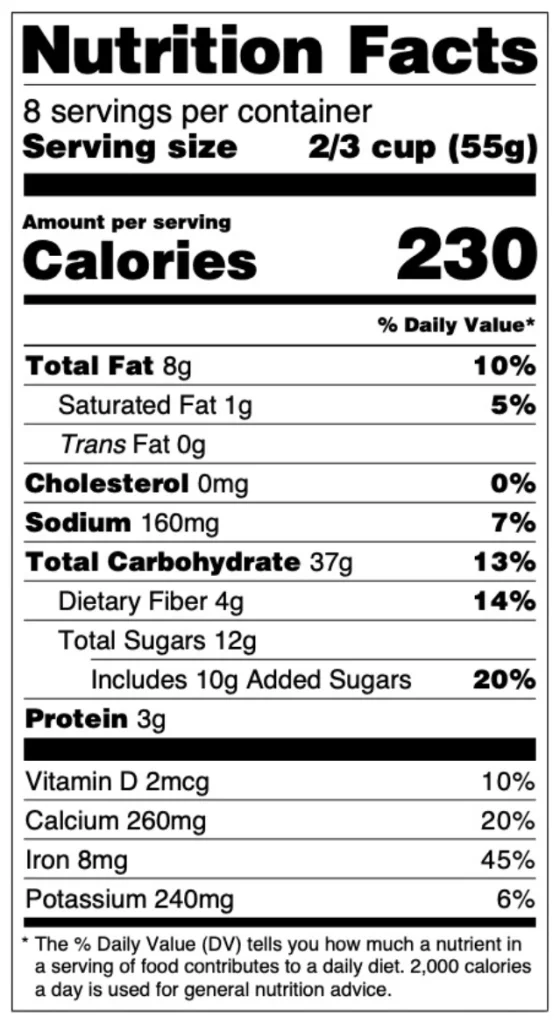
DG Sante (European Union) / FSA (UK)
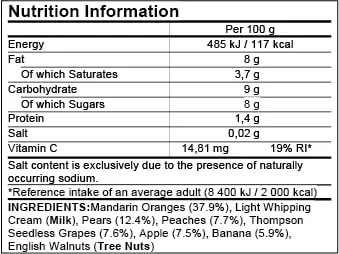
CFIA (Canada)
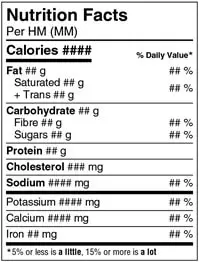
COFEPRIS (Mexico)
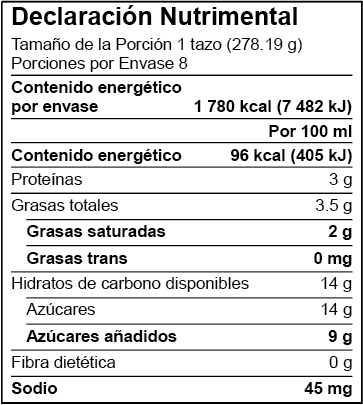
Core Nutrition Facts Panel Components Across Regions
Creating compliant nutrition facts labels requires a thorough understanding of both mandatory and voluntary elements across different regulatory bodies. Let’s examine how these requirements vary by region, while focusing on essential nutrient content and consumer transparency.
Mandatory Label Elements For Your Nutrition Facts Label
- Energy/Calories
Energy content presentation varies significantly by region:
- FDA (US): Calories must be prominently displayed and is typically the largest text on the nutrition facts label.
- UK/EU: Requires both kilojoules (kJ) and kilocalories (kcal) to be displayed in a dual-unit presentation.
- CFIA (Canada): Mandates calorie declaration for standard labels and bilingual label presentation (“Calories/Calories”).
- COFEPRIS (Mexico): Energy content must be displayed below the calorie amount, with Front-of-Package (FOP) Warning Labels required for displaying excess calorie warnings.
- Macronutrients
All regions require core macronutrient declarations, although the order they are listed might vary. Macronutrients that must be declared are:
- Total Fat: Including breakdowns of saturated fat and trans fats.
- Proteins: Listed with consistent units across regions.
- Total Carbohydrates: Including dietary fiber and total sugars.
- Total and Added Sugars: With varying declaration requirements by region.
Regional variations in display order must be strictly followed to ensure compliance.
- Micronutrients
Required vitamins and minerals vary by jurisdiction:
- FDA: Mandates Vitamin D, calcium, iron, and potassium be declared.
- UK/EU: Focuses on commonly deficient nutrients in the European population.
- CFIA: Requires specific nutrients important to Canadian dietary needs.
- COFEPRIS: Vitamins and minerals are a voluntary consideration but must still align with Mexican public health priorities.
Each region sets specific percentage daily values based on local dietary guidelines.
Voluntary Label Elements
Beyond mandatory declarations, manufacturers may include:
- Additional nutrients that might be important
- Qualified health claims (subject to regional restrictions)
- Enhanced nutrient content claims
These voluntary declarations must still comply with strict regional guidelines and cannot mislead consumers about the product’s nutritional value.
This complex landscape of nutrition labeling requirements underscores the importance of working with comprehensive labeling solutions that understand both mandatory and voluntary elements across different regions. For food manufacturers operating in multiple markets, staying current with these requirements is essential for maintaining compliance and building consumer trust.
Front-of-Pack vs Back-of-Pack Nutrition Facts Label Requirements
The evolution of nutrition facts labels has led to distinct requirements for both front and back package panels, with different regions implementing varying approaches to help consumers make informed food choices.
Front-of-Pack Label Systems
UK Traffic Light System
The UK employs a color-coded system to help consumers quickly assess nutrient content:
- Red: High levels of nutrients of concern
- Amber: Medium levels
- Green: Low levels
- Color coding criteria
- Nutrient thresholds
- Display requirements
Nutrient thresholds are specifically defined for:
- Fats
- Saturated fats
- Sugars
- Salt
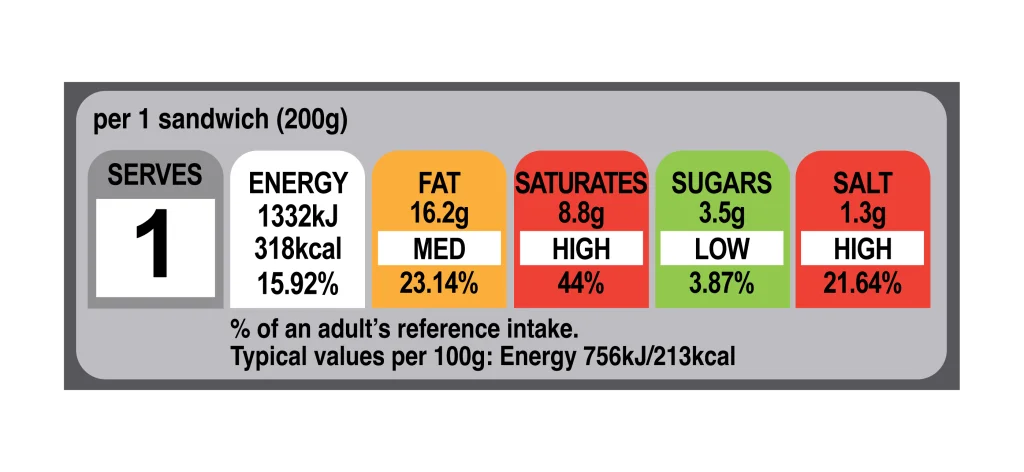
Mexico’s Warning Labels
COFEPRIS requires prominent octagonal warning symbols for:
- Excess calories
- Excess sugars
- Excess saturated fats
- Excess trans fats
- Excess sodium
- Added caffeine
- Added sweeteners
These black octagonal stop signs must be:
- Clearly visible on the principal display panel
- Proportional to package size
- Unobstructed by other design elements

Canada’s FOP Requirements
The CFIA has implemented new front-of-pack warning requirements:
- Mandatory symbols for “high in” nutrients of concern
- Clear specifications for symbol size and placement
- Being implemented with a phased timeline through 2026
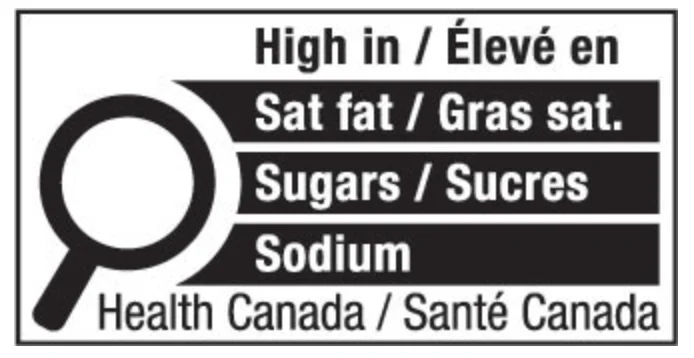
Back-of-Pack Label Requirements
Detailed nutritional information on the back panel must include:
- A complete nutrition facts table
- Comprehensive ingredient listings
- Clear and obvious allergen statements
- Manufacturing information
- Required statements about nutrient content claims
- Information about eating occasions and servings per package
Label Format Requirements and Design Specifications
Creating compliant nutrition facts labels requires careful attention to format and design specifications across different regions.
Panel Placement and Layout
The principal display panel must follow specific requirements:
- Clear visibility on the package front
- Proper information hierarchy
- Appropriate warning label placement where required
- Consistent spacing and formatting
Font and Typography
FDA Standards
US labels must adhere to strict typography rules:
- A legible sans-serif font such as Helvetica or Arial is recommended, but not strictly mandated.
- Point sizes are specifically defined:
- “Nutrition Facts” header: 13 point
- Serving size information: 8 point
- Nutrient declarations: 6 point minimum
- Bold text requirements for specific elements
EU/UK Guidelines
European standards focus on legibility:
- Minimum x-height of 1.2mm for standard packages
- Reduced size allowance (0.9mm) for small packages
- High contrast requirements between text and background
- Clear spacing between elements
CFIA Requirements
Canadian labels must accommodate bilingual text:
- Sans serif fonts required
- Minimum 6-point size for all text
- Equal prominence for both languages
- Clear separation between language sections
COFEPRIS Specifications
Mexican requirements emphasize visibility:
- Clear contrast standards
- Prominent warning label display
- Specific octagonal stop sign format for warnings
- Minimum visibility requirements
Space and Sizing Guidelines
Package size affects label requirements as it will determine how you present your nutrition facts label.
For regular-sized packages (like a cereal box):
- Use the standard nutrition label format
- The text must be large enough to read easily
- All required information must fit comfortably
For smaller packages (like energy bars):
- You can use special “mini” versions of the label
- Less information may be required
- Text can be slightly smaller, but still readable
The basic rule is simple: bigger packages need bigger labels with more information, while smaller packages can use simplified labels that show just the essential details. These rules ensure that customers can always read and understand what’s in their food, while keeping your business compliant with regulations.
Product-Specific Label Requirements
Different product types require specialized labeling approaches:
Dual Column Requirements:
- Single-serving vs. multi-serving presentations
- As-prepared vs. as-sold nutritional values
- Per-serving and per-package declarations
Multi-Unit and Variety Packages:
- Aggregate nutritional information
- Individual component declarations
- Serving size clarity
- Combined nutritional values
These specialized requirements ensure that food products maintain compliance while providing consumers with accessible nutritional information, regardless of package size or product type.
Language and Translation Requirements
Bilingual Label Requirements
Canadian Requirements (CFIA)
All packaged food products must display the following:
- Equal prominence for English and French text
- Identical information in both languages
- Space management considerations include:
- Parallel format displays
- Alternate bilingual formats for small packages
- Consistent terminology across languages
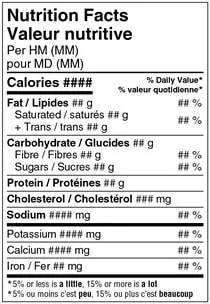
Mexican Requirements (COFEPRIS)
Labels must feature:
- Spanish as the primary language
- Optional English translations
- Accurate translation verification
- Consistent nutrition facts presentation

Multiple Language Label Considerations
When including more than one language on your food label, you need to make sure:
- Everything fits without making the text too small to read
- The same information and message appears in each language without anything getting lost in translation
- You’re following the rules for each country where you’ll sell your product
The key is to plan your label design carefully so that whether a customer reads it in English, French, Spanish, or any other required language, they’ll get the same clear information about what’s in their food.
Special Nutrition Labeling Considerations
Allergen Declarations
Priority allergens vary by region but must be clearly declared:
FDA (US):
- Nine major allergens
- “Contains” statement format
- Source labeling requirements
EU/UK:
- 14 major allergens
- Bold or highlighted text
- Clear allergen emphasis
CFIA (Canada):
- Eleven priority allergens
- Bilingual declarations
- Source identification
COFEPRIS (Mexico):
- Updated list of major allergens
- Clear Spanish declarations
- Warning statements
Common Labeling Compliance Pitfalls
Food manufacturers frequently encounter several critical challenges when creating nutrition facts labels for multiple markets.
Regional Labeling Issues
Creating compliant nutrition labels across different regions presents several critical challenges that impact compliance and consumer trust. Firstly, it is easy for errors to occur when calculating nutrient values or serving sizes, especially when converting between different measurement systems or accounting for variations in different regions. These errors can lead to significant compliance issues and potentially mislead consumers about the nutritional content of products.
Companies might use the incorrect label templates or forget to include required warnings. Translation mistakes are another area of confusion, as what works in English might not make sense in French or Spanish. These inaccuracies in multilingual labels can create confusion or compliance issues.
Many companies also struggle to keep their labels looking consistent across different markets while still following local rules. Additionally, food labeling laws keep changing so it’s easy to fall behind on the latest requirements. These mistakes can lead to expensive recalls or prevent you access from selling in certain markets.
Labeling Pitfall Prevention Strategies
There are several practical ways to avoid these compliance hurdles. First, your business needs to have strong quality control measures in place. This means checking labels carefully before they go to print, having multiple people verify the information, and double-checking that everything meets the requirements for each country where you’ll sell your product.
Your business also needs to have a systematic review process. Think of it like a checklist: Are all the calculations correct? Have you included everything required for each country? Are you using the right format? Regular audits essentially help catch any issues before they become problems.
Finally, make sure your team knows what they’re doing. This means:
- Training them on the latest regulations
- Teaching them about requirements in different countries
- Making sure they understand quality control procedures
By following these strategies, you can avoid common labeling mistakes and keep your products compliant in all your markets. Remember, it’s much cheaper to prevent mistakes than to fix them after your products are already on store shelves.
Leveraging Digital Labeling Solutions
Modern food manufacturers increasingly rely on digital tools to streamline the labeling process and ensure compliance. Food Label Maker offers a comprehensive solution that addresses the complexities of international nutrition labeling requirements. Their platform provides:
- Advanced label generation capabilities that automatically adjust to regional requirements and create accurate nutrition facts panels.
- Multi-language support facilitates compliance with various market requirements while maintaining consistency across translations.
- Automated calculations reduce the risk of errors and ensure accuracy in nutrient declarations.
- Regular regulatory updates keep labels current with the latest guidelines for the country you are selling products in, such as the European Commission or the Food and Drug Administration bodies.
The platform’s template library offers pre-approved formats for different regions, while compliance-checking tools verify adherence to current regulations. This integrated approach helps food manufacturers maintain consistent quality across all markets while reducing the resource burden of manual compliance checking.
Read through their extensive Regulatory Hub for more information on these nutrition facts labeling standards.
Final thoughts on global nutrition labeling requirements
Successfully navigating international nutrition facts label requirements demands precision, consistency, and reliable compliance tools. Food manufacturers must balance technical accuracy with regulatory compliance while maintaining efficient operations across multiple markets.
By understanding regional variations, implementing robust quality control measures, and utilizing digital solutions like Food Label Maker’s comprehensive platform, companies can ensure their products meet all requirements while supporting informed consumer choices. You can get started today by creating a food label using our free tool or viewing our pricing plans to find the right package for your business.
As regulations continue to evolve, staying current with compliance requirements and leveraging automated solutions becomes increasingly crucial for sustainable success in the global food industry.

